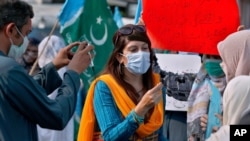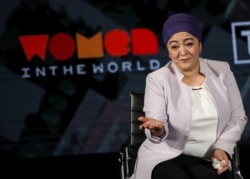A new study into the representation of women in media says news organizations should do more to include female perspectives.
The first step to achieving that equity is for journalists to acknowledge that imbalance exists in newsrooms and news production, Luba Kassova, who authored the report, told VOA.
The report, “The Missing Perspectives of Women in News” — commissioned by the Bill and Melinda Gates Foundation — focused on India, Kenya, Nigeria, South Africa, Britain and the U.S. It looked at four indicators: diversity in the workplace, newsroom leadership, women as sources and as figures in news stories, and coverage of gender equality issues.
Overall, marginal progress has been made in the past 10 years, the report found. It challenges policymakers and newsroom leadership to double female representation in coming years to present more balanced perspectives of issues.
When it comes to workplace diversity, “there are no success stories” in any of the countries the study examined, Kassova, who is director of AKAS, said at a media briefing Tuesday. AKAS is an international audience strategy group commissioned to carry out the study.
Top positions in the newsroom remain largely a reserve of the men, and the absence of female voices in the decision-making process means news about women and for women is mostly decided by men, Kassova said.
The world “is missing out on the perspective of half of its population,” Pamella Makotsi Sittoni, executive editor of Kenya’s Daily Nation, told VOA
Women will continue to be denied their right to be heard or to take up leadership or influential positions in the media if the imbalance persists, Makotsi Sittoni said.
“There is an opportunity when you have equality to tap from both sides and to tap from both perspectives, and that is what we are missing out on by leaving out women,” the Kenyan journalist said.
The study found an imbalance in the news gathering process, which continues to give preference to male voices. Between 2005 and 2015, “fewer than one in five experts globally in the news were women,” and today, the report said, men are quoted in online news five times more often than women in Nigeria, and six times in India.
The report analyzed news content and academic articles to create a database, and it used Google trends and surveys to collect data in the six countries. More than 2,000 articles and three case studies were considered, and the content of nearly 12,000 publications and more than 56 million stories were analyzed.
The researchers found that women have the best coverage in lifestyle stories, where their voices are captured more than in news linked to policymaking or current affairs.
Similarly, of the 19 beats analyzed, lifestyle reporting was where female journalists have most parity. Women tend to be assigned coverage of education, environment, and issues of poverty and development, with fewer assigned to investigative reporting, the economy, or politics within newsrooms, the study found
When it comes to expert sources cited in politics coverage, men’s voices were up to seven times more likely to be heard than that of women. This further dwindles in economic issues where male experts were up to 31 times more likely to be featured than women. In all six countries, women were two to 15 times more likely to appear in the arts and media news genre than in articles on the economy, researchers found.
The study found that with the exception of India, “gender representation in political news coverage is lagging behind women’s actual position in political life in Kenya, the U.S., South Africa, and the UK.”
The researchers found no indication that the Me Too movement had an impact on coverage of women’s issues in the U.S. and Britain, Kassova told VOA. The campaign against sexual harassment and abuse gained prominence in 2017 when Hollywood celebrities and others spoke publicly about their experiences.
Generally, researchers found that the more rooted the patriarchal norms, the bigger the barrier to gender equality. In such countries, both sexes appear to believe that women must be subservient to men — a perception mirrored in the news environment.
The report’s findings should be addressed holistically and intentionally, Makotsi Sittoni said. The Kenyan journalist said those in the media should be more proactive and inclusive in eliminating gender biases in newsrooms.
Report author Kassova agreed, saying change is possible but only if newsrooms push for it.









